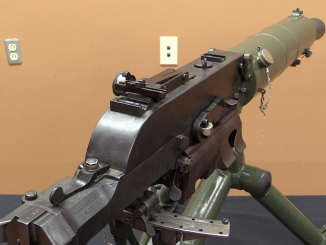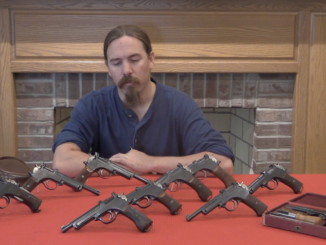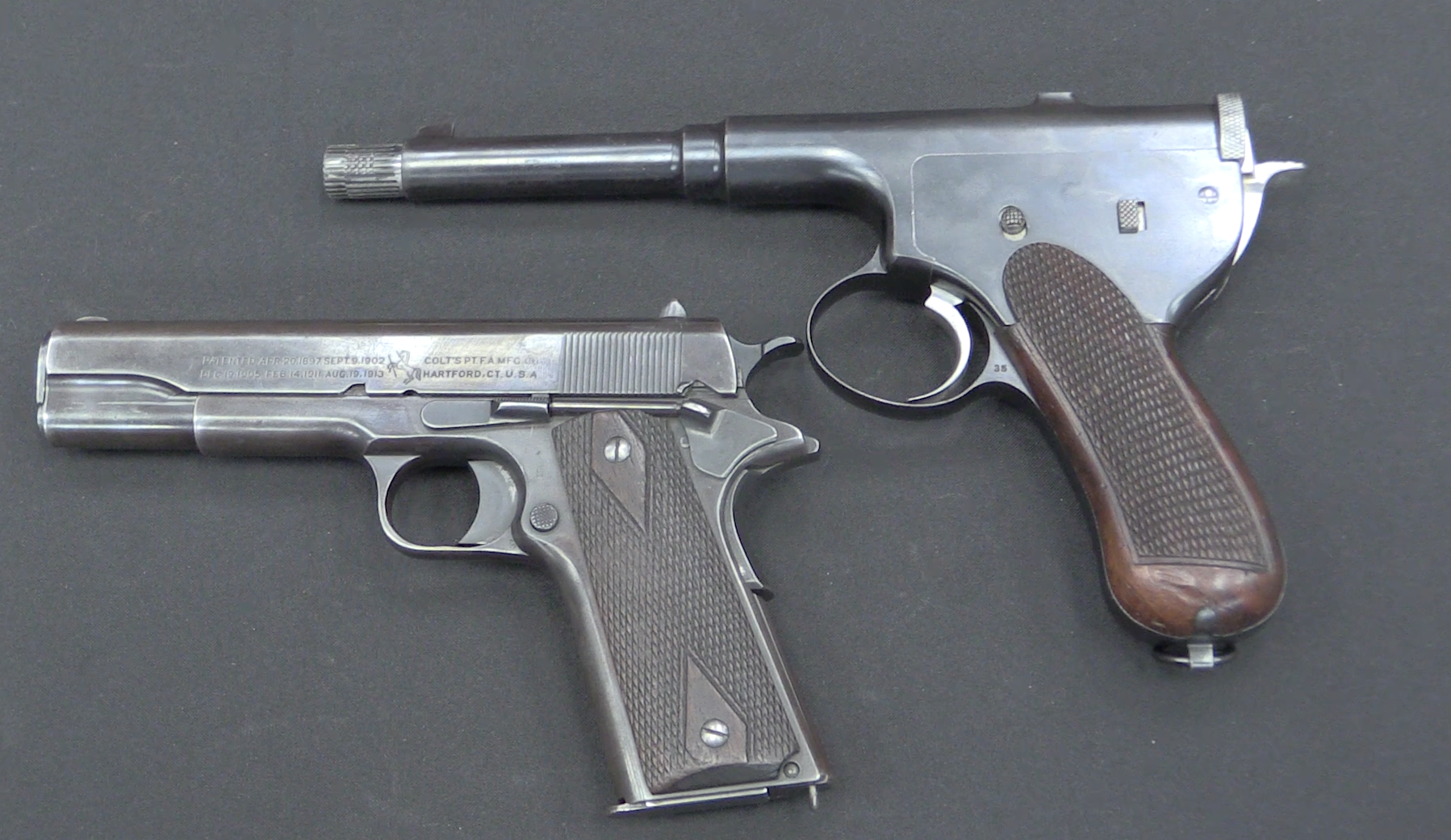Austria was a hotbed of early repeating handgun design, first with manually operated designs and shortly thereafter with self-loaders. One of the men contributing to this development in the 1880s was Josef Schulhof, a farmer-turned-gunsmith who had a number of patents and designs to his credit. His first pistol was developed in 1884, and this particular 1887 model was an experimental improvement. It is chambered for the .320 British revolver cartridge, and has an 8-round tubular magazine built into the grip. As with many early repeaters, it uses a finger ring to cycle the action, and a sheath-type trigger to fire. I was able to open up the sideplate on this one, and we get a really good look at exactly how it all works.




The 1894 model illustrated in Ezell’s book (p.139)loaded from the “front”, through a flap right under the ejection port. In fact, it looks a lot like the loading system of the (much) later Johnson self-loading rifle with the rotary magazine.
Not knowing what’s inside, I’m wondering if that model had a Winchester or Spencer-type coil spring arrangement behind its follower rather than the spring running parallel to the magazine as in this example.
cheers
eon
The bit at the end answered my question – so this is a manually cycled pistol that a skilled operator could cycle with one hand pretty quickly.
Cowboy action shooters and the like can cycle single-action-armies at stunning speeds, but that’s a two handed operation.
Do keep in mind that I was cycling the gun empty. I don’t know how much more difficult or slower it would be if you were actually extracting a spent case and lifting a full magazine with the lever.
I can see how the first round is fed when the magazine is full. A feed finger grabbed the last round and pulled it up.
However, how did subsequent rounds get pushed up the magazine? Were there additional feed fingers for each position in the magazine to “walk” the rounds up through the tube? Or am I missing something here?
It looks to me like the feed tab snaps over the rim of a round right at the bottom of the magazine tube as you push it up in the hole. Then when you push the next round in, it shoves the first one upwards in the tube and the tab snaps past its rim.
Once the full eight rounds are in, the tab is bearing on the rim of the last round, and pushes up on it with every movement of the ring lever.
The setup works a lot like the tube magazine in the Schulhof rifle, except that it just has one tab. The rifle had a series of tabs arranged rather like an endless chain to feed rounds up to the lifter from a magazine in the stock;
http://www.google.com/patents/US267265
If you have trouble figuring it out, you’re not alone. Among other things, the magazine in the rifle was a weird mixture of a tube magazine and a hopper-type gravity feed. I suspect it only worked properly (assuming it worked at all) if the rifle was held more-or-less level and upright. I’d hate to have had to try firing steeply uphill, or lying in a rollover prone position with the rifle canted to left or right.
As the old engineers’ saying goes, “If nobody else does it ‘that way’, there’s usually a very good reason why”.
cheers
eon
The Schulhof rifle was tested in Russia in 1881 (in trials which eventually led to choice of Mosin 1891 rifle), В.Е. Маркевич in Ручное огнестрельное оружие write that Schulhof rifle was original construction, magazine hold 28 full-power rifle cartridge. 25 shots can be fired in 30 seconds, it was tested in Russia in 1881 and rejected due to:
-complication (rifle would be expensive in production)
-low stock durability [remember that it was 1881 year, so rifle was considered not only as a fire-arm but also as mace]
-magazine was awkward to load
In Russia also the Шульгофф—Кемминг, 1888 г. (i don’t known Latin version: Kemming? Hemming?) was tested, it features “central drum magazine” (Russian: Магазин центральный барабанный), the Russian test version has following parameters:
Magazine for 9 cartridge, caliber: 7.5mm, muzzle velocity: 524m/s, straight-pull bolt-action.
“and rejected due to:”
I forget most viable objection: -magazine was prone to jamming
Early models worked exactly like the rifle – with a separate feed finger for each cartridge, and a matching tooth in the magazine tube so the cartridges couldn’t just slide back down.
They even had a small hopper feeding the tube. (Or should that be “box magazine”? At least on the prototype, there’s a flat spring pushing the cartridges sideways into the tube; it’s not shown in the patent, though.)
I’m pretty sure the tube itself remained unchanged when he omitted that hopper/magazine.
If a lever-action pistol like this one or a Laumann were still around in 1940, would it be best used with a suppressor? I recall that the Welrod Pistol was a manually operated “silent weapon.” And given the finger loop on the Schulhof, I guess that the Welrod would lose in terms of re-cocking speed. Anyone want to experiment, since manually operated pistols and the Nagant revolver are quieter than semi-autos?
As with most lever-action rifles, I suspect the racket of this beast’s action working would be much more noticeable than the relatively quiet sound of the Welrod’s bolt. (Actually, given a drop of oil and a bit of working to “wear it in”, and the Welrod can be worked pretty quietly.)
Rather like the DeLisle carbine (SMLE variant in 0.45in ACP) the low signature of the shot just makes the sound of the action that much more noticeable.
For a real eye-and-ear opener, fire a Sten MKIIS, an OSS suppressed M3, or an ex-SEAL Karl Gustaf M45 or S&W M76 suppressed SMG on full-auto, about a five-shot burst. It still sounds like a freaking rivet gun at work due to the action plus some residual gas pressure in the chamber as the mouth of the case being extracted clears the chamber mouth. This is typical of all API blowback SMGs, but you only really notice it when you subtract the muzzle signature from the equation, so to speak.
BTW, at least one of our covert agencies used to use the old Dan Wesson DA revolvers in .357 with the interchangeable barrels as suppressed weapons. Those came with a feeler gauge to set barrel-cylinder gap. They would use one of the barrels (usually one of the longer ones) to artifice a special suppressed barrel, its casing taking the place of the usual DW outer barrel shroud.
By setting the barrel/cylinder clearance gap to the absolute minimum consistent with the cylinder actually rotating when the hand came up, they reduced the sideblast from the gap to almost nothing. It had to be cleaned meticulously and used only with subsonic rounds (which you would do anyway, of course), but if anything, it made less noise than a Nagant 1895 with a suppressor simply because of better workmanship on the action. The DA action just operated more smoothly than any Nagant you ever saw.
And a 160 or 180-grain .357 slug traveling at about 1,050 F/S makes a considerably bigger impression at the receiving end than the Nagant’s or Welrod’s little .30 to .32 “pill”.
I don’t know if they ever used a .44 Dan Wesson for this sort of work, but it could have used off-the-shelf “medium velocity” 250-grain lead SWC .44 Magnum ammunition, which is good for about 1,060 F/S and 500 FPE at the muzzle.
One of those is just about guaranteed to ruin your whole day.
cheers
eon
Cool mechanism, I hadn’t thought of… The “ancestors” making pistols in-between the advent of the semi auto from the revolver, manual operation. I have thought of manual operated pistols myself, and I’ve seem some the Remington Rider pistol, and Semmerling for example.
With manually operated pistols coming about during the transition period between the two if you will, although really I suppose they were instrumental in the latters development in that once they made one doubtless they thought about it doing it itself.
Or someone else did, once they saw them. Like the folk at Steyr for example, this does sort of have the lines of a revolver like other early pieces, Bergmanns etc.
can anyone find a patent drawing for the 1887 repeating pistol?